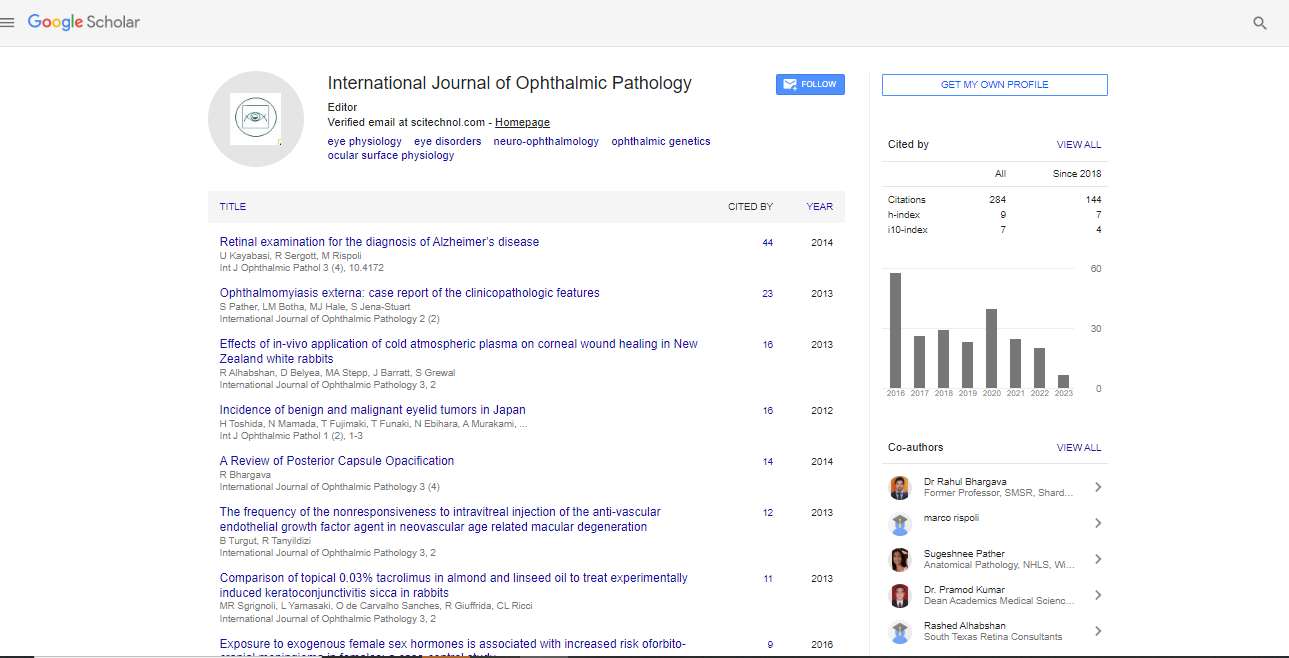Research Article, Int J Ophthalmic Pathol Vol: 6 Issue: 3
Human Immunodeficiency Virus (HIV) Related Conjunctival Tumours
Ibanga A1*, Ekanem IA2, Nkanga DG1, Asana UE1, Duke RE1, Etim BA1, Nnoli M2, Ugbem TI2 and Irabor G2
1Department of Ophthalmology, University of Calabar Teaching Hospital (UCTH), Nigeria
2Department of Pathology, University of Calabar Teaching Hospital (UCTH), Nigeria
*Corresponding Author : Dr. Affiong A Ibanga
Department of Ophthalmology, University of Calabar Teaching Hospital, Calabar, Nigeria
Tel: +234 87 232 055
E-mail: draffiongibanga@yahoo.com
Received: June 12, 2017 Accepted: July 14, 2017 Published: July 21, 2017
Citation: Ibanga A, Ekanem IA, Nkanga DG, Asana UE, Duke RE, et al. (2017) Human Immunodeficiency Virus (HIV) Related Conjunctival Tumours. Int J Ophthalmic Pathol 6:4. doi: 10.4172/2324-8599.1000209
Abstract
Background: The huge burden of HIV/AIDS in sub-Saharan Africa has been associated with increased prevalence of malignant conjunctival tumours especially squamous cell carcinoma (SCC). In Nigeria, the national HIV sero-prevalence is 3.4%, and values in the South-South geopolitical zone where this review was performed ranges from 4.1% in Delta to 10.9% in Akwa-Ibom state. Aim: To review HIV and conjunctival tumours in patients seen at the University of Calabar Teaching Hospital (UCTH), Calabar Methodology: This retrospective clinic review of demographic data, clinical features, HIV sero-status and histopathologic findings in patients with conjunctival tumours seen from January 2005 to December 2014 including Ophthalmology clinic records and pathology request forms were analysed Results: A total of 32,102 new patients were seen in the ophthalmic outpatient within the study period, of which 108 patients comprising 57(52.8%) males and 42(38.0%) females had conjunctival tumours. Their ages ranged from 11-85 years, with a mean of 39 years ± 14.98. Histologically, eighty (74.1%) had Squamous cell carcinoma, ten (9.26%) Squamous intraepithelial lesion, six (5.56%) Papilloma, four (3.7%) Kaposis sarcoma, three (2.78%) Naevus and Melanoma each, one each (0.93%) had Conjunctival dysplasia and Lymphoma. The HIV status of only 55 (50.9%) could be ascertained having been documented in patients’ records of whom thirty-seven (67.3%) were HIV positive. Thirty four (>90%) of the HIV positive cases had squamous cell carcinoma. The other 3 patients had kaposis sarcoma, papilloma and conjunctival intraepithelial neoplasia(CIN). Conclusion: In Calabar, conjunctival squamous cell carcinoma is preponderant in HIV sero-positive patients when compared with the sero-negatives.
 Spanish
Spanish  Chinese
Chinese  Russian
Russian  German
German  French
French  Japanese
Japanese  Portuguese
Portuguese  Hindi
Hindi 